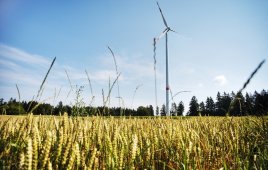
Investors can profit from wind-energy tax credits that provide jobs and reduce energy costs in low- and moderate-income communities.
A fact sheet describing how national banks and Federal savings associations (FSA) can make investments intended to promote public welfare and take advantage of wind-energy tax credits has been released by the Office of the Comptroller of the Currency (OCC) (www.occ.gov). Under the public welfare investment (PWI) authority, national banks and FSAs can invest in wind-energy facilities that primarily benefit low- and moderate-income (LMI) communities or meet other specified economic development criteria. This includes benefitting LMI individuals or government targeted-redevelopment areas. They also include instances in which the wind investment would receive consideration as a “qualified investment” under the Community Reinvestment Act (CRA) regulations.
A major focus of the PWI authority is job creation in economically targeted areas. When the location of a wind energy-producing facility qualifies as a PWI project, the bank or FSA investor must also demonstrate that there is job creation in order to meet the public welfare standard. For example, if a project is located in an LMI area and creates permanent jobs, the investing institution typically would be able to provide a sufficient basis for establishing the public welfare benefit. For wind energy-producing facilities, permanent jobs primarily involve maintenance and servicing.
Under the PWI authority, there is potential for a wind project to reduce energy costs for residents and affordable housing developments. This energy cost reduction may provide a basis for the PWI investment authority.
Wind projects in formally adopted, government-targeted redevelopment areas also receive consideration under this authority. A legally incorporated town, city, county, tribal, or federal government agency or entity could make such a designation. Examples of formally-designated redevelopment areas could include:
- Federal empowerment zones
- Brownfield sites
- Rural communities
- State enterprise zones
- City tax incremental financing districts
Additionally, if a project does not meet any of the above mentioned requirements, it might be able to qualify as a PWI under the CRA “qualified investment” criteria. Under these criteria, wind projects that revitalize or stabilize LMI areas or rural, middle-income, underserved or distressed communities would be eligible under the PWI authority as well.
An example of a national bank’s wind investment approved under the PWI authority was a project that financed the construction and operation of a small-scale wind turbine facility in an LMI area.
The PWI authority has separate limitations and approval processes for national banks and FSAs. A national bank’s aggregate investments under the PWI authority cannot exceed 5% of the bank’s capital and surplus. This limit may be increased up to 15% if the OCC approves the bank’s proposal requesting regulatory permission to exceed the 5% limit for its aggregate PWIs. Limits for an FSA’s aggregate investment may vary depending on the legal authority used to process the transaction. The OCC requires that national banks and FSAs that invest in wind projects have the requisite expertise and risk management capabilities within their organizations to manage the investments. WPE
Filed Under: Featured, Financing




